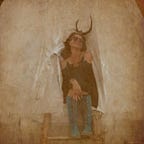Crossroads: Physical Artworks, Digital Data on Blockchain
What is it about blockchain?
I know. I know… blockchain…
I’ve worked in software development for over 20 years now. I’ve seen computing fads come and go, buzzwords proliferate then fade away, bandwagons everyone jumps on only to jump onto the next one a few short months later.
Maybe I’m a bit jaded by now.
We’ve had a few teams spin up around blockchain at work. And it seems as though the most common reaction to the mention of blockchain from many software developers is a slight roll of the eyes and a (fairly heavy) sigh.
This appears to be for two very different reasons as far as I can tell:
- The person understands blockchain and is weary of the hype that leads others to propose blockchain as the solution for every problem.
- The person understands the technical idea but doesn’t see exactly how blockchain is different, in key ways, from technologies that have been around since before I started my career.
On further consideration, there is a third reason:
3. The person doesn’t understand and thinks that blockchain is just Bitcoin and they’ve read all the stories about Bitcoin. And they’re so over the hype.
A solution looking for a problem
I was somewhere between 1 & 2 on that list last year. I was watching from the sidelines with interest, following the news, and, experimenting here and there with how the technology actually works.
There seemed to be quite a lot of “if we build it, they will come” projects at the time. Which is fine. It’s a way for people to learn what it is, how it works, and what it can be useful for. Unfortunately, this often isn’t how these projects are portrayed. Still, it is a good way to learn what is useful and what is not. I always learn more by actually doing things than any other way.
Beyond the technical
Quite a large part of blockchain’s image isn’t anything to do with the actual technology itself. It seems more to do with the ideals put forward to go along with it: decentralised, open source, peer-to-peer, community based, pure maths. Those are true to a greater or lesser extent depending on the implementation. But they are ideals that many people believe strongly in. That means that blockchain isn’t just a technology, it can become a worldview.
An intersection of worlds
For me, the whole ‘blockchain thing’ became a 'thing' when I came across a use case that applied to the 'other half' of my life: as an artist, rather than as a software engineer.
Provenance (which the dictionary says is: “a record of ownership of a work of art, used as a guide to authenticity or quality”) and authenticity are really important in the art world. For artworks attributed to famous painters, it can add (or wipe away) millions of dollars in the value of a piece.
So, I was intrigued when I saw the art world exploring the use of blockchain technology.
Art world meets blockchain
Artists have been exploring the space around blockchain for some time. You can read all about it in the excellent blog by Artnome, so I won’t repeat it here.
But one of the turning points, as I see it, was the Christie’s auction of the Barney A. Ebsworth collection. Where each piece in the auction came with a card that links the artwork to its provenance information, stored via blockchain.
You can listen to an excellent interview with Nanne Dekking, CEO of Artory, who partnered with Christie’s to provide the blockchain solution on the Art Law Podcast.
For me, this was a sign that things could be moving beyond the (interesting, niche but growing) bubble of 'crypto art' into applications that general artists and collectors would find valuable.
Imagining the future
As mentioned in that podcast, the art world in general, and its institutions in particular, moves slowly. There are a lot of people with a vested interest in seeing things remain the same. And I understand the positioning of the Artory solution. But I’m more interested in making the future, rather than trying to fix the past. (And I’m a living artist, so naturally, I’m thinking about what can we do now to not have the sorts of provenance and authenticity issues going forward. More on that in a moment.)
Today saw the launch of PeerArt, a peer-to-peer art marketplace with no friction, no middle man, no fees. The promise of what blockchain can achieve. What makes this quite special, though, is that it is an excellent example of Origin Protocol’s Marketplace Creator which requires no coding to create. Initiatives like this are just the kind of ecosystem growth that you want to see in an emerging technology. You can read more about PeerArt and Origin Protocol on Coleman Maher Medium account.
What next?
Back to the issues of provenance and authenticity. I don’t think the Artory solution, or other solutions similar to it, go far enough. Or, more accurately, they aren’t solving the problem that I, as a living artist, have. However, I did find a solution that looks very promising: BAC (Blockchain Art Collective). I just received my Starter Kit and will be testing out this solution shortly myself. (As I said, I learn best by doing!)
I’m also proposing a project on Kickstarter that would get this into the hands of 100 people with a limited edition set of 100 original encaustic wax paintings — physical art — registered and tagged with the BAC certificate of authenticity — digital record — stored on a permissioned EVM blockchain.
You can see more details (and back the project!) here: 100Crows.
Until next time,
Festina Lente my friends!
